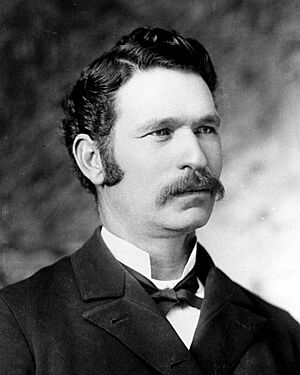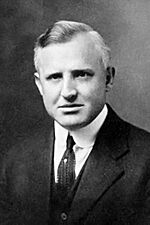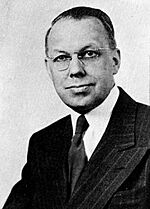History of Brigham Young University facts for kids
|
"I hope to see an Academy established in Provo... at which the children of the Latter-day Saints can receive a good education unmixed with the pernicious atheistic influences that are found in so many of the higher schools of the country." |
| — Brigham Young, 1875 |
The history of Brigham Young University (BYU) starts in 1875. Back then, it was called Brigham Young Academy (BYA). The school officially became a university in 1903. This happened because the school's leaders, called the board of trustees, agreed to a request from BYU president Benjamin Cluff. BYU became a nationally recognized university under the leadership of Franklin S. Harris. After World War II, the school grew a lot, becoming the largest private university at that time. BYU's story is closely linked to its sponsor, The Church of Jesus Christ of Latter-day Saints (LDS Church).
Contents
BYU's Beginnings: How It All Started
BYU's roots go back to 1862. That's when Warren and Wilson Dusenberry opened a school in Provo. It was in a building called Cluff Hall. Warren Dusenberry paid the rent and even built the desks himself. In 1865, he left the school because of money problems.
In 1869, the Dusenberry brothers started another school in Provo. This one did very well! They moved to a bigger building and formed a committee to help run the school. It became so popular that it was chosen to be the first branch of the University of Deseret. It was renamed the Timpanogos Branch. More than 300 students attended, which was even more than the main University of Deseret.
However, the school faced money troubles again and closed. Then, on October 16, 1875, Brigham Young stepped in. He was the president of the LDS Church and owned the building. He signed a document to create a new school, which he had been planning for a while. This date is usually considered the founding date of BYU. Young separated the school from the University of Deseret and named it "Brigham Young Academy." One of the first leaders on the board was Martha Jane Knowlton Coray, who represented women's interests.
Classes at the new BYA began on January 3, 1876. Reed Smoot was the first of 29 students to sign up that day. Warren Dusenberry was the temporary principal. In April 1876, Karl G. Maeser, a German immigrant chosen by Brigham Young, became the principal. In January 1884, a fire in a chemistry lab destroyed the school building. Students had to hold classes in different places. They eventually moved to a warehouse until a new building, the "BY Academy Building," was finished in January 1892.
Benjamin Cluff, Jr.: A New Approach
After Karl Maeser, the board of trustees needed a new president. Maeser was busy overseeing all LDS Church schools. They chose Benjamin Cluff, a recent graduate from the University of Michigan. Cluff had very different ideas from Maeser. Maeser was traditional and kept his teaching focused on LDS beliefs and classic education. Cluff was more open to new ideas and believed the school could learn a lot from the world outside Mormonism.
At this time, BYA was still more like a high school than a university. Some students were even at an elementary level. Cluff started making changes based on his experiences at Michigan. He began to separate the college from the high school. This gave older students access to more advanced subjects. He also started an athletics program, but the board quickly closed it down. Many colleges back then didn't approve of sports programs. The school was supported by local community members. It wasn't officially sponsored by the LDS Church until July 18, 1896.
Cluff continued his unique style in 1900. He took a group of students on a trip to Mexico. They wanted to explore lands mentioned in the Book of Mormon and find the ancient city of Zarahemla. At the Mexican border, they met Heber J. Grant, a leader in the church. Grant didn't approve of the trip and asked Cluff to turn back, but Cluff refused. The group went on an 18-month adventure through the jungle. They faced illness and even spent time in a Mexican prison. Cluff and his group returned to BYA in 1902. He served successfully for two more years, and the school doubled in size. However, one of the men from the Mexico trip accused Cluff of various wrongdoings. Even though Cluff was found innocent, his reputation was damaged, and the board had to find a new president.
In his final official act, Cluff suggested that BYA be renamed "Brigham Young University." Many board members disagreed at first, thinking the school wasn't big enough to be a university. But the idea eventually passed. One person who disagreed, Anthon H. Lund, later said, "I hope their head will grow big enough for their hat."
George H. Brimhall: Leading the New University
In 1903, BYA officially split into two schools: Brigham Young High School and BYU. The high school's class of 1907 was responsible for the famous giant "Y" that you can still see on the mountain near campus today. The board chose George H. Brimhall as the new BYU president. Brimhall didn't have as much formal education as previous leaders. He didn't even finish high school until he was forty! But he was a great speaker and organizer.
In 1904, the new BYU bought 17 acres (about 69,000 square meters) of land from Provo. This land was called "Temple Hill." Many people thought the LDS Church would build a temple there. Because of this, some people didn't want BYU to buy the land. But thanks to a BYU student named Byron Owen Colton, the concerns were settled, and the deal went through. This Temple Hill land is where the current BYU campus began. In 1909, construction started on the first building on the new campus, the Karl G. Maeser Memorial.
By 1910, Brimhall had hired many new teachers with advanced degrees, including PhDs. This was a big step for the school. Brimhall, like other presidents, believed in letting his staff handle many duties. However, problems soon arose. Some teachers believed the school should teach organic evolution, while others disagreed. This argument ended with the LDS Church president, Joseph F. Smith, deciding that evolution would not be taught. Two teachers were fired, and several others resigned to support them. Many wondered if the school would survive this difficult time. Some even called the school just a "religious seminary." However, many students who graduated during this period went on to achieve great success in their fields.
Growth and Expansion: From Harris to Wilkinson
Franklin S. Harris became BYU's president in 1921. He was the first president to have a doctoral degree. Harris made important changes, helping the school improve greatly. He reorganized the college into a true university. He also worked hard to get the school officially recognized, or "accredited." When he started, no major organization recognized BYU as a university. By the end of his time, BYU was accredited by all major groups. He served for 24 years, longer than any other BYU president. He left in 1945 to work at Utah State University.
Howard S. McDonald replaced Harris. McDonald was used to a system where the president made most decisions, not a board of trustees. This made it hard for him to work with BYU's board, who had more power than he was used to. Still, he achieved important things in his four years. World War II had just ended, and thousands of students came to BYU. By the end of his time, the school had grown almost five times, with 5,440 students! BYU didn't have enough buildings for so many students. So, McDonald bought part of an Air Force Base in Ogden, Utah, and rebuilt it to house some students. He also started a big building program that his successors continued. McDonald resigned in 1949 to work at a college in Los Angeles that fit his leadership style better.
After a short time with Christen Jensen as temporary president, Ernest L. Wilkinson was appointed by the board. Wilkinson's time as president was a period of huge growth. The school started a fast building program. Wilkinson was responsible for building over 80 structures on campus, many of which are still used today. During his leadership, the student body grew six times larger. This made BYU the biggest private school at the time. The quality of students also improved, leading to higher education standards. Wilkinson also reorganized the LDS Church groups on campus, adding many new stakes and wards.
Alpine Summer School: Learning in Nature
Aspen Grove is a camp for BYU alumni and families. In 1911, Eugene L. Roberts used this spot as the starting point for the school's yearly hike to Mount Timpanogos. Ten years later, the landowner gave 35 acres of the property to BYU. The Alpine Summer School was set up there in 1922. Students lived in tents to study animals, plants, geology, insects, and art. The first directors were Martin P. Henderson, Fred Buss, and Clawson Y. Cannon. The school later built a kitchen, dining hall, and dorms. However, the camp was closed during World War II.
Raymond Beckham, who directed the BYU Alumni association, raised money to reopen Aspen Grove as an alumni camp. Construction began in 1962, adding running water, a sewage system, and a swimming pool. The camp officially opened on July 13, 1963. It is open all year and now hosts thousands of guests for family vacations, reunions, youth conferences, and retreats.
Modern Era: From Oaks to Bateman
Dallin H. Oaks became president in 1971, taking over from Wilkinson. Oaks continued the school's expansion. He added a law school and planned for a new School of Management. A new library was also built during his time, doubling the library space on campus. Oaks was appointed to the Utah Supreme Court in 1980.
Jeffrey R. Holland then became president. Holland encouraged a mix of excellent education and religious faith at the university. He believed the school's religious nature was a great strength that should be used, not hidden. During his time, the university added a campus in Jerusalem, now called the BYU Jerusalem Center. When the new campus faced local opposition, Holland personally visited protesters. He promised in writing that no one connected with the campus would try to convert others. This helped the Center to be successfully completed. In 1989, Holland became a general authority in the church.
Rex E. Lee replaced Holland. Lee was responsible for the Benson Science Building and the Museum of Art on campus. Lee bravely fought cancer, but eventually passed away. BYU honors him every year with a cancer fundraiser called the Rex Lee Run.
Merrill J. Bateman became president in 1996. From 1996 to 1999, Bateman oversaw the expansion of the Harold B. Lee Library. He also made several buildings stronger in case of an earthquake. Later, he started plans for the Joseph F. Smith Building, which was finished in 2004. Bateman was responsible for building 36 new buildings for BYU, both on and off campus. This included the Barlow Center in Washington D. C.. This center provides a place for students to stay and gives BYU a presence in the city.
Sports programs also grew under Bateman. A women's softball team was created. He also helped create the Mountain West Conference, which BYU's sports teams joined. Before that, BYU was in the Western Athletic Conference. Sports programs did very well during Bateman's time. In technology, Bateman directed the merging of BYU's computer systems with the LDS Church's. He also increased resources for computer science students. A BYU satellite TV network also started in 2000 under his leadership. Bateman was president during the September 11th attacks in 2001. The attacks happened just hours before the weekly devotional at BYU. The plans for the devotional were changed, and Bateman led the students in a prayer for peace.
|
See also
- Brigham Young University
- List of Brigham Young University buildings
- Academic freedom at Brigham Young University
- BYU Cougars
- Student life at Brigham Young University
- Church Educational System Honor Code
- List of Brigham Young University alumni
- Brigham Young High School







